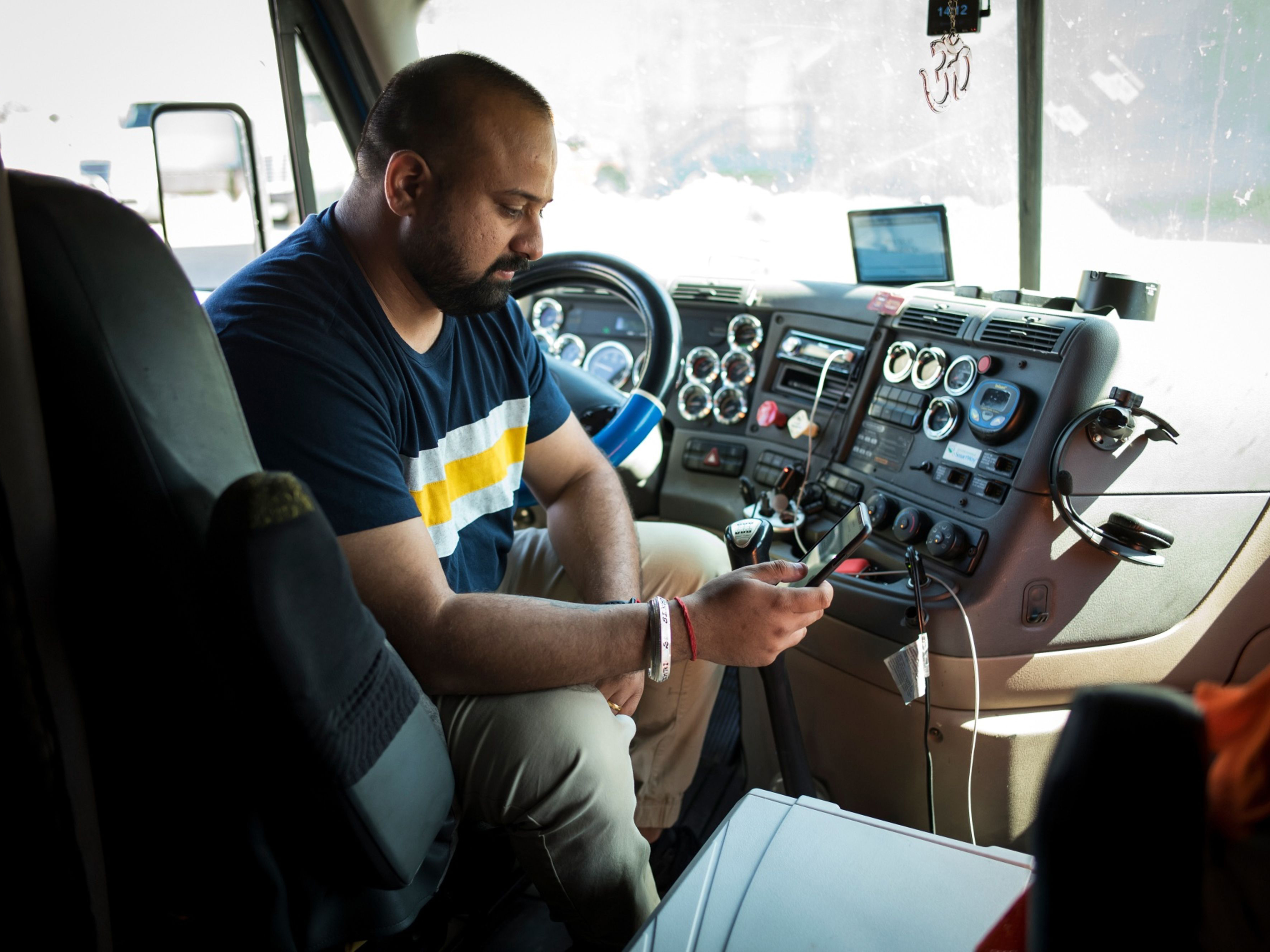
Time is of the essence in the supply chain, especially for truck drivers picking up and delivering goods. Customers not only expect their orders to arrive safely, but service providers see on-time delivery as essential for keeping supply chains operating efficiently.
Drivers must complete a series of time-consuming tasks, from getting into a facility to picking up a load, leaving the facility, driving to the destination, getting into the destination facility and completing the delivery. In recent years, drivers have sounded off about being delayed at facilities as long as three to five hours, according to a DAT Solutions survey. And according to data from MIT researcher David Correll, truck drivers on average spend only about six and a half hours a day driving, out of 11 available hours — a slight improvement from six hours a couple of years ago. With drivers’ time on the road limited by hours-of-service regulations, coupled with long dwell times, companies are losing money waiting for trailers to be unloaded.
COVID-19 threw another wrench into the works, as facilities faced a labor shortage and many drivers took time off to protect their own health. Restrictions such as mask mandates and social distancing were put into place to help ensure the health and safety of drivers and facility workers alike, which in turn only added to delays.
Shippers and carriers are turning to technology to overcome these new supply chain challenges. One process that requires a lot of personnel interaction, and has been specifically targeted for improvement, is the transfer of the bill of lading (BOL).
Overhauling the BOL
In the early stages of COVID-19, the Consumer Brands Association (CBA) gathered key members to identify areas where processes could be made safer and more expeditious. It created a task force composed of industry associations, manufacturers, third-party logistics providers, carriers, retailers and technology vendors, with the aim of facilitating collaboration, standardization, digitization and automation across the supply chain. The result was a contactless electronic bill of lading (eBOL) standard for the pickup and delivery process.
From the time an item is manufactured overseas to when it reaches the end consumer, both the product and accompanying BOL have switched hands multiple times. There’s the original equipment manufacturer, initial carrier, vessel crew, port staff, other port employees, the carrier again, a potential distributor, more carriers, and finally the retail store. With products being mass shipped and divided at ports or distribution centers, this leaves room for error when it comes to BOL accuracy. What’s more, all of those touch points spread germs.
By contrast, an eBOL can help create a valid, blockchain-like record of a product’s journey from origination to end consumer, resulting in less human error, faster turnaround times and fewer physical paper forms being passed around.
The Early Returns
By eliminating the need to physically hand off documents, an eBOL not only makes sense in terms of protecting against the spread of COVID-19, but also creates efficiencies in getting drivers in and out of facilities more quickly. Early tests of the new contactless pickup and delivery standard by participating members of the CBA task force have shown an average decrease in driver dwell times from 66 minutes to 23 minutes.
The industry has long faced a serious driver shortage. As a result, the supply chain is being stressed by heavy demand and not enough capacity, driving up shipping costs that are passed on to the end consumer.
Adding back time to a driver’s day could significantly impact the supply chain. Just adding one stop per day to a route could help relieve the capacity crunch, stabilize shipping prices and result in savings for consumers.
While the contactless standard for pickup and delivery continues to evolve with each new deployment, early results show the positive impact it could have on shippers and carriers alike. But for the new standard to have a major impact, it will need to experience widespread adoption across an industry that has typically been slow to adopt new technology. With COVID-19 spiking once again, now would be a perfect time for companies across the supply chain to implement the contactless pickup and delivery standard, not only to boost efficiencies but also help protect the health of all workers.
Will Chu is chief executive officer and co-founder of Vector, a contactless pickup and delivery platform.
Time is of the essence in the supply chain, especially for truck drivers picking up and delivering goods. Customers not only expect their orders to arrive safely, but service providers see on-time delivery as essential for keeping supply chains operating efficiently.
Drivers must complete a series of time-consuming tasks, from getting into a facility to picking up a load, leaving the facility, driving to the destination, getting into the destination facility and completing the delivery. In recent years, drivers have sounded off about being delayed at facilities as long as three to five hours, according to a DAT Solutions survey. And according to data from MIT researcher David Correll, truck drivers on average spend only about six and a half hours a day driving, out of 11 available hours — a slight improvement from six hours a couple of years ago. With drivers’ time on the road limited by hours-of-service regulations, coupled with long dwell times, companies are losing money waiting for trailers to be unloaded.
COVID-19 threw another wrench into the works, as facilities faced a labor shortage and many drivers took time off to protect their own health. Restrictions such as mask mandates and social distancing were put into place to help ensure the health and safety of drivers and facility workers alike, which in turn only added to delays.
Shippers and carriers are turning to technology to overcome these new supply chain challenges. One process that requires a lot of personnel interaction, and has been specifically targeted for improvement, is the transfer of the bill of lading (BOL).
Overhauling the BOL
In the early stages of COVID-19, the Consumer Brands Association (CBA) gathered key members to identify areas where processes could be made safer and more expeditious. It created a task force composed of industry associations, manufacturers, third-party logistics providers, carriers, retailers and technology vendors, with the aim of facilitating collaboration, standardization, digitization and automation across the supply chain. The result was a contactless electronic bill of lading (eBOL) standard for the pickup and delivery process.
From the time an item is manufactured overseas to when it reaches the end consumer, both the product and accompanying BOL have switched hands multiple times. There’s the original equipment manufacturer, initial carrier, vessel crew, port staff, other port employees, the carrier again, a potential distributor, more carriers, and finally the retail store. With products being mass shipped and divided at ports or distribution centers, this leaves room for error when it comes to BOL accuracy. What’s more, all of those touch points spread germs.
By contrast, an eBOL can help create a valid, blockchain-like record of a product’s journey from origination to end consumer, resulting in less human error, faster turnaround times and fewer physical paper forms being passed around.
The Early Returns
By eliminating the need to physically hand off documents, an eBOL not only makes sense in terms of protecting against the spread of COVID-19, but also creates efficiencies in getting drivers in and out of facilities more quickly. Early tests of the new contactless pickup and delivery standard by participating members of the CBA task force have shown an average decrease in driver dwell times from 66 minutes to 23 minutes.
The industry has long faced a serious driver shortage. As a result, the supply chain is being stressed by heavy demand and not enough capacity, driving up shipping costs that are passed on to the end consumer.
Adding back time to a driver’s day could significantly impact the supply chain. Just adding one stop per day to a route could help relieve the capacity crunch, stabilize shipping prices and result in savings for consumers.
While the contactless standard for pickup and delivery continues to evolve with each new deployment, early results show the positive impact it could have on shippers and carriers alike. But for the new standard to have a major impact, it will need to experience widespread adoption across an industry that has typically been slow to adopt new technology. With COVID-19 spiking once again, now would be a perfect time for companies across the supply chain to implement the contactless pickup and delivery standard, not only to boost efficiencies but also help protect the health of all workers.
Will Chu is chief executive officer and co-founder of Vector, a contactless pickup and delivery platform.







